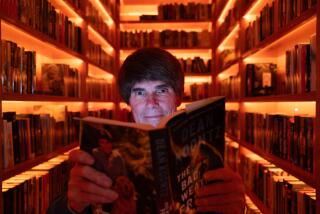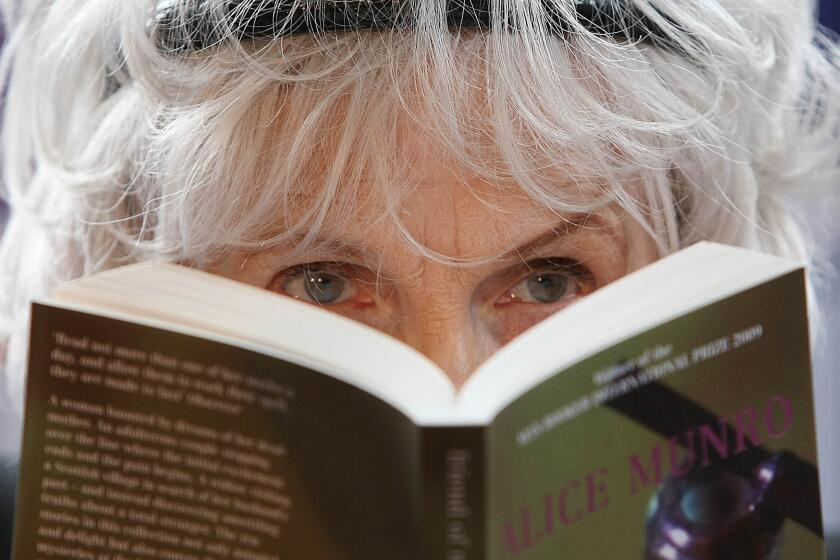Peep show
“ON Seeing,” a brilliant if also unsettling book of essays on the power of human sight and how it is used and abused, starts with a wry account of an incident that took place in Paris during the French Revolution. What F. Gonzalez-Crussi manages to achieve in his telling of the tale is typical of the beguilement and black humor found throughout his work. But it also warns the reader that the author, a pathologist by profession, brings a certain sense of the macabre to his musings on the human body.
A couple of voyeurs placed themselves beneath the viewing stand at a ceremony in commemoration of the storming of the Bastille “to get a good view of the bodily parts hidden under women’s skirts.” When the men were discovered in their hiding place, supplied with a hamper of food and drink and hard at work drilling eyeholes in the planking, an old woman denounced them as terrorists -- their wine bottles, it was believed, contained kerosene with which they intended to set fire to a ceremonial structure called the “Altar of the Fatherland.” An angry mob set upon the peeping Toms with pikes and sabers, and the two malefactors were separated from their heads.
For Gonzalez-Crussi, the story is merely one illustration of the consequences -- some comic, some dire -- that follow from the simple fact that the male of the human species has always been curious to see the genitalia of the female. Indeed, he decorates his musings with anecdotes and observations that allow us to consider the same theme from a dozen vantage points, a veritable catalog of voyeuristic moments from the sweep of human civilization. As a result, each essay in “On Seeing” is a short but lively course in history and culture, high and low, ancient and modern.
In the title essay, for example, Gonzalez-Crussi invokes the ancient myth of Diana, who turns the hunter Actaeon into a stag after he dares to spy on the naked goddess at her bath. He describes how James Whistler, famous for painting his own fully clothed mother, reacted to the sight of a nude female torso in a painting by a colleague, Gustave Courbet. Whistler recognized the genitals as those of his own mistress, and he concluded that she had surely betrayed him while posing for Courbet. Gonzalez-Crussi describes a 1991 one-woman show presented by Annie Sprinkle, a former prostitute and porn star, who invited audience members to examine her cervix with a speculum. And he touches on how the miniaturization of the video camera has created a new form of voyeurism known as “upskirting.”
Male curiosity, Gonzalez-Crussi concludes, is driven by something other than mere titillation. He acknowledges that fear may be at work, “an obscure, ancestral fear of a sex that seems to them mysterious, hidden, intricate and puzzling.” But it is characteristic of the author that he always seeks deeper and more exalted meanings in what he beholds and describes. “There is perhaps fear, such as what the unknown commonly inspires, but it is admixed with reverence, fascination, admiration and morbid attraction,” he concludes. “Man senses here the ineffable power of the Giver of Life, who shall become, unavoidably, chief mourner and Lictor of Death, our death.”
A doctor who is also a gifted writer and a deep thinker, Gonzalez-Crussi belongs in the company of such fellow physicians as Sherwin B. Nuland (“How We Die”), Spencer Nadler (“The Language of Cells”) and Oliver Sacks (“The Man Who Mistook His Wife for a Hat”). Though Gonzalez-Crussi is a superb stylist, his background in medical science manifests itself in the way he perceives the workings of the human body: He is always willing to analyze but never to rhapsodize.
A good example can be found in “Eyes on Privities,” in which he ponders the various rituals that human beings have adopted for the viewing of bodily functions, including the formal witnessing of royal births and videotaping births in hospitals today. The author acknowledges that human birth is a momentous affair, but he insists on telling it like it is: “[A]part from its rich metaphysical significance, we must admit that it is a rather messy affair.... [E]very time I looked at the just born, instead of conjuring images of triumphant life, I thought of a foot-soldier in a defeated army, a pitiful survivor in a catastrophic retreat, dragging himself painfully amidst the wreck and bloody devastation that follow a terrible battle, which he fought and lost.”
No aspect of human anatomy or biological function is neglected in “On Seeing.” The author ponders the well-attended daily ceremony during which the Manchu empress dowager answered the call of nature and also why 15th century painters and preachers regarded the depiction of the human anatomy as a theological matter. He shows us the gruesome experiments conducted on the severed heads of condemned prisoners to determine whether death by guillotine was, as advertised, instantaneous and thus merciful. (Perhaps not!) And he describes the so-called trial by congress practiced in 17th century France in which a man whose wife sought an annulment on grounds of impotence had to prove himself by performing the conjugal act in front of witnesses.
“[I]t was not uncommon for altercations to arise between estranged married couples,” he observes. “As is well known, these quarrels are strongly inhibitory for the male, who under such circumstances was likely to come out the loser party.”
At moments, the author points out what is not seen even though it is displayed in plain sight. One patient in the insane asylum at the Salpetriere Hospital in 19th century Paris, for instance, was diagnosed by the medical staff as suffering only from “the inability to sit down.” But when Gonzalez-Crussi deconstructs photographs of the unfortunate man, whose face is contorted with panic as he clutches the edge of a chair, he sees something that apparently escaped the clinicians: “[A] picture of a man who feels that he is being ejected from existence, as from a roller-coaster in free fall; the image of a man in the midst of existential vertigo, whirling down headlong on a precipitous course that -- he knows -- is not far removed from death.”
Gonzalez-Crussi is fascinated by the depiction of the human form, whether for scientific, sacred or profane purposes. Indeed, he understands that there are important differences between an altarpiece, a medical photograph and a French postcard, but he insists that there are similarities too. He pauses to point out that Augustine, whom he describes as “the renowned saint and former playboy,” once asked with irony why “the gods could have sexual intercourse with mortal women any time they wanted, but men almost never found occasion to do the same with Olympian goddesses.”
At a certain emblematic moment in “On Seeing,” Gonzalez-Crussi contemplates how remarkable it is that a two-dimensional depiction of the naked human body -- or the mere memory of such an image -- is sufficient to elicit a powerful sexual response in the body of one who views it. For the author, it is a fact that expresses something fundamental about both human anatomy and human civilization -- “that a distinguishing characteristic of human beings, one that identifies them as fundamentally different from animals, is (apart from the capacity to laugh, and to know that they must die) the ability to make love with ghosts.”
Here we glimpse what makes “On Seeing” such an exceptional work. As a pathologist, Gonzalez-Crussi possesses a technical mastery of the human body’s interior structure and functioning. As a reader and observer, he possesses a powerful insight into the workings of the human mind. When he applies his expertise and insight to the events, artifacts and personalities of several thousand years, he is able to discern meanings that escape the eye of the professional scholar and critic. Above all, he displays a rare gift for expressing and explaining what he sees, in ways that are truly eye-opening. *
More to Read
Sign up for our Book Club newsletter
Get the latest news, events and more from the Los Angeles Times Book Club, and help us get L.A. reading and talking.
You may occasionally receive promotional content from the Los Angeles Times.






